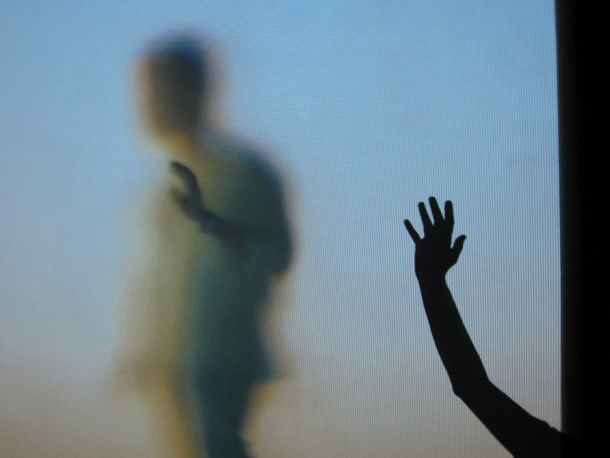Art Without Borders
The first thing I notice upon walking into the exhibit space is that it is very dark; the room is large and empty, save for a few other viewers. In rows, displayed on the walls surrounding me are enormous projections of long windows, which reveal dark shadows and silhouettes of people moving on the other side of the windows. The silhouettes of what appear to be two male figures engaged in conversation as they stand with their backs to the window immediately catch my eye. Above them, a shadow rests upon the ceiling: a group of people, their sharp edges and lines a stark contrast to the way in which their bodies seem to melt into one another, hunch over as they appear to be staring down at me. I cast a quick glance around the room. There appears to be a dozen or so of these shadow-people moving and living through the windows. My interest piqued, I reach for one of the headsets which rest on a wall behind me. Through the earpieces, I hear a conversation between two people, the words swirling multifariously in a language incomprehensible to me, and through the other piece, an English translation. I realize I am listening to the voices of the two men I noticed when I first walked in. “They caught me today. I am being deported.” “I can’t get my papers in order.” “I haven’t seen my family in over six years.”
I am at the Polish Pavilion on the Venice Biennale, an art festival which takes place over the course of six months. The Biennale occurs every two years and attracts international and contemporary artists who wish to showcase their work in art’s global epicenter. This year, it will remain on display until November 22. The central theme binding all the works together, “Making Worlds,” is quite open-ended.
I was particularly struck by the pavilion of Polish artist Krtysztof Wodiczko. His interpretation of the year’s theme merged the realms of art and politics in such a manner that I became unsure of where one ended and where the other began. The piece I mentioned earlier reflects the political and social reality of modern-day Europe. As the caption on the entrance wall of his pavilion explained, the protagonists of his exhibition are immigrants who “not being ‘at home’ remain eternal guests, strangers deprived of rights who remain mute, invisible, and nameless to communicate, gain a voice or make a presence in a public space.”
The focus on immigration conjured up a reality I had witnessed firsthand while studying abroad in Italy last semester. Economic and political disequilibrium between Western and Eastern Europe has spurred the immigration of less wealthy Eastern Europeans to the more affluent West. These Eastern European immigrants are often so eager for a better life that they disregard the issue of legality, and many of those who settle in the “New World” run great risks. It is an archetypal but tragic story: these immigrants leave their families and risk their own safety over the course of the trip. Once they’ve reached their desired destinations, though, they find themselves unemployed and in constant hiding from authorities who wish to deport them. There are linguistic and cultural barriers which hinder communication between them and those who “belong” in those countries, legally and socially speaking. Social assimilation is next to impossible.
As I stand before the exhibit, I wonder why it has called to mind these reflections and thoughts. What is it about his work that has prompted me to sift through recollections and experiences I have accumulated over the course of my entire lifetime? I gradually realize that it is precisely this self-reflection that Wodiczko has sought to elicit: it is not the art he is framing, but my emotional awareness of the issue. And this framing is multifaceted: Wodiczko, through controlling the images I see and the soundtrack I hear, has thoughtfully crafted a version of reality which causes me to rethink my own thoughts and feelings through the artist’s chosen perspective.
Wodiczko, by having me frame myself and observe myself seeing reality through the perspective forced upon me, makes me fully conscious of what it is to ignore other people’s individuality and humanity, of the shadows that other people have become. He places me inside the inner sanctum, while the “outsiders” peer at me through the hazy glass. I am the “insider,” I am the culprit. But I hold no prejudice. I support open labor migration, open borders, and poorer countries joining the EU.
Do I? Art, through emotion, self-discovery, and provocation, is a medium of communication through which people can achieve a deeper, more personal, type of political awareness. The viewer may feel threatened by what he sees, accused, guilty, or confused. It will make him think twice, look again, and look inside. Art cannot create political change in itself. Instead, the artist provokes, and the viewer reacts.

